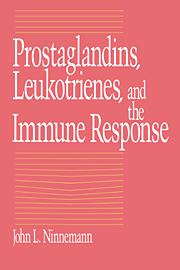Book contents
- Frontmatter
- Contents
- Foreword by James S. Goodwin
- Preface
- 1 A brief history and introduction
- 2 Prostaglandin/leukotriene structure and chemistry: a primer
- 3 Monocytes and macrophages
- 4 Lymphocyte response
- 5 Inflammation and the neutrophil
- 6 Malignancy and the arachidonic acid cascade
- 7 Tissue and organ transplantation
- 8 Rheumatoid arthritis and autoimmunity
- 9 Traumatic injury and surgery
- 10 Allergy
- Index
3 - Monocytes and macrophages
Published online by Cambridge University Press: 24 November 2009
- Frontmatter
- Contents
- Foreword by James S. Goodwin
- Preface
- 1 A brief history and introduction
- 2 Prostaglandin/leukotriene structure and chemistry: a primer
- 3 Monocytes and macrophages
- 4 Lymphocyte response
- 5 Inflammation and the neutrophil
- 6 Malignancy and the arachidonic acid cascade
- 7 Tissue and organ transplantation
- 8 Rheumatoid arthritis and autoimmunity
- 9 Traumatic injury and surgery
- 10 Allergy
- Index
Summary
The monocyte/macrophage has a variety of immunological functions including presentation of antigen to lymphocytes, production of immunologically active mediators such as interleukin 1(IL-1), and regulation of cell–cell cooperation and activity. This cell is essential for the development of almost all normal immunological responses. Activated macrophages can also act as cytotoxic effector cells that are especially critical to antimicrobial and antitumor defenses (1).
Monocytes, macrophages, and macrophagelike cells produce a number of mediators critical to immune responsiveness. For example, IL-1 is secreted by macrophages, macrophagelike cells (such as Langerhans cells of the skin), and by astrocytes, keratinocytes, fibroblasts, and natural killer (NK) cells (2). Collectively, these mediator-producing cells are called accessory cells (3). Accessory-cell IL-1 is directly involved in the activation of helper-T lymphocytes, and the stimulation of a variety of other cell types to produce “secondary mediators” with far-reaching influence. As summarized in Figure 3.1, these secondary mediators include prostaglandins and leukotrienes.
THE EFFECT OF PROSTAGLANDINS ON MACROPHAGE FUNCTION
The products of arachidonic acid metabolism are important regulators of macrophage activity and macrophage–lymphocyte cooperation. Many studies have been devoted to examining the effects of prostaglandin E on macrophages. In these studies, PGE has been shown to have a profound inhibitory effect on the release of lysosomal hydrolase in human macrophages, as well as on macrophage locomotion, shape change, and phagocytosis (4).
- Type
- Chapter
- Information
- Prostaglandins, Leukotrienes, and the Immune Response , pp. 34 - 52Publisher: Cambridge University PressPrint publication year: 1988
- 3
- Cited by



